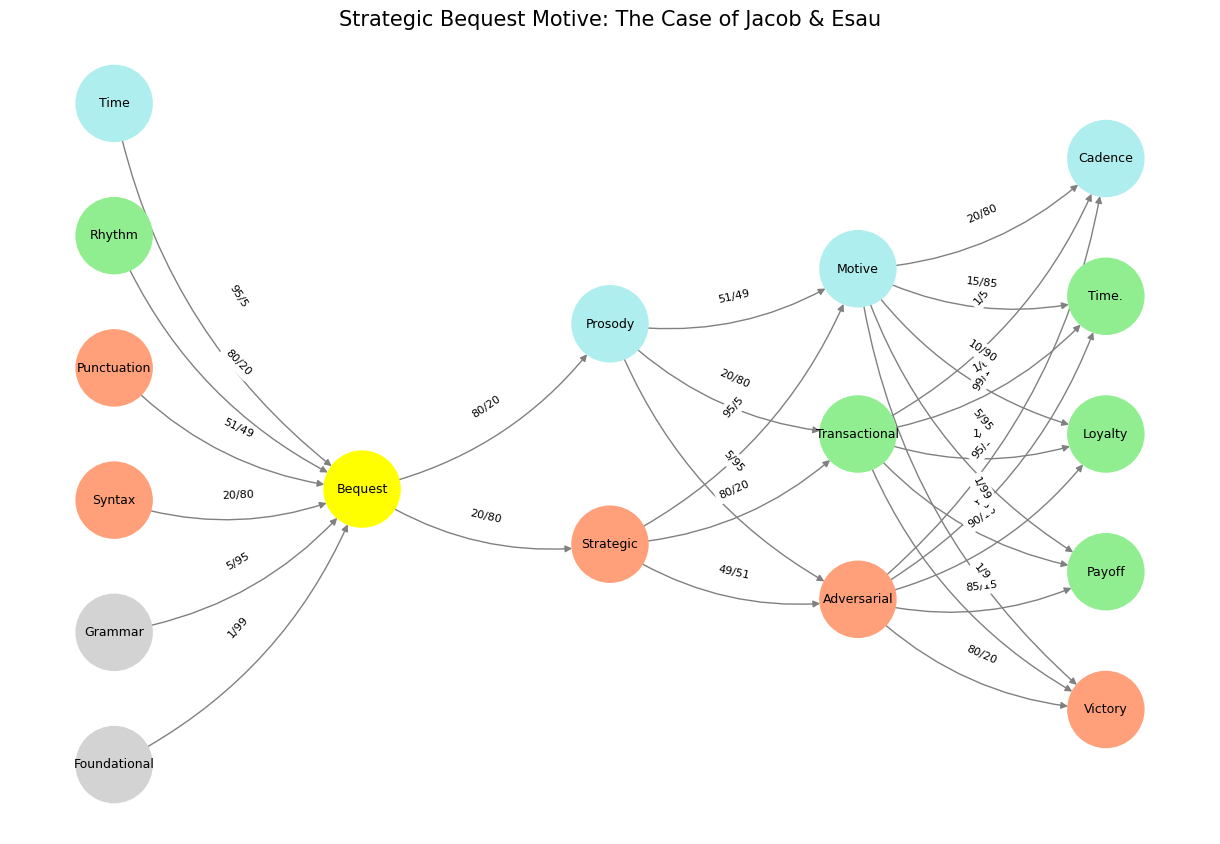Freedom in Fetters#
Jacob and Esau: A Study of Pretext, Subtext, Text, Context, and Metatext#
The biblical narrative of Jacob and Esau, found in Genesis 25-33, is a rich tapestry of familial conflict, divine providence, and human ambition. It is a story that transcends its ancient origins, offering timeless insights into the dynamics of inheritance, power, and perception. By examining the story through the lenses of pretext, subtext, text, context, and metatext, we can uncover layers of meaning that resonate with contemporary themes, such as the strategic bequest motive exemplified by the Murdoch empire and dramatized in Succession. This essay will explore how the story of Jacob and Esau operates within these five layers, drawing parallels to the OPRAH model (Overarching Ecosystem, Perception, Reason, Action, and Heaven) to illuminate its enduring relevance.
Pretext: The Overarching Ecosystem#
The pretext of the Jacob and Esau narrative is rooted in the cultural and theological ecosystem of ancient Israel. The story is set within a patriarchal society where inheritance and birthright were central to familial and societal structures. The birthright, typically reserved for the firstborn son, was not merely a matter of material wealth but also of spiritual and social authority. In this ecosystem, the stakes of inheritance were high, as they determined the continuity of a family’s legacy and its place within the broader covenant with God.
The Murdoch empire, as described in the provided material, operates within a similarly high-stakes ecosystem. The media landscape, with its shifting tides of technology and public sentiment, demands strategic foresight to ensure the longevity of influence. Just as Isaac’s blessing was not merely a transfer of wealth but a conferral of covenantal authority, Rupert Murdoch’s bequest is not just about financial assets but about maintaining control over political and cultural narratives. Both stories highlight the importance of understanding the ecosystem in which inheritance occurs, as failure to adapt to its pressures can lead to the erosion of power.
Subtext: Perception and Manipulation#
The subtext of the Jacob and Esau story lies in the manipulation of perception. Jacob, whose name means “supplanter,” lives up to his name by deceiving his father, Isaac, into granting him the blessing intended for Esau. This act of deception is not merely a personal betrayal but a calculated maneuver to alter the trajectory of inheritance. Jacob’s success hinges on his ability to manipulate Isaac’s perception, exploiting his father’s blindness—both literal and metaphorical—to secure the blessing.
This theme of perception as a tool of power is echoed in the Murdoch empire. As the material notes, “Perception is not truth but the manipulation of truth’s contours.” In Succession, Logan Roy’s ability to shape perception is the cornerstone of his power. Similarly, Jacob’s actions demonstrate that inheritance is not just about receiving power but about understanding how to wield it through the control of narrative. Esau’s failure to grasp this principle—his inability to see beyond the immediate satisfaction of his hunger when he sells his birthright—ultimately leads to his downfall.

Fig. 27 The Next Time Your Horse is Behaving Well, Sell it. The numbers in private equity don’t add up because its very much like a betting in a horse race. Too many entrants and exits for anyone to have a reliable dataset with which to estimate odds for any horse-jokey vs. the others for quinella, trifecta, superfecta#
Text: Reason and Strategic Decision-Making#
The text of the Jacob and Esau narrative centers on the strategic decisions that drive the plot. Jacob’s actions are not impulsive but calculated, reflecting a deep understanding of the stakes involved. His acquisition of Esau’s birthright in exchange for a bowl of stew is a transactional move, while his deception of Isaac is a more adversarial gambit. Both actions reveal Jacob’s strategic mindset, as he navigates the complexities of familial dynamics to secure his future.
This aligns with the “Reason” layer of the OPRAH model, which emphasizes the importance of a rational framework for decision-making. In the Murdoch context, the strategic bequest motive requires heirs to possess not just wealth but the cognitive architecture to optimize it. Jacob’s success lies in his ability to think strategically, whereas Esau’s impulsiveness and lack of foresight render him unfit for the responsibilities of inheritance. The narrative thus underscores the importance of reason in ensuring the continuity of power.
Context: Action and the Exercise of Power#
The context of the Jacob and Esau story is defined by the actions taken by its characters. Jacob’s deception is a bold and risky move, but it demonstrates his willingness to act decisively to achieve his goals. In contrast, Esau’s failure to act strategically—whether in selling his birthright or in his delayed response to Jacob’s deception—reveals his inability to exercise power effectively.
This dynamic mirrors the “Action” layer of the OPRAH model, which highlights the importance of decisive governance in maintaining an empire. In Succession, the Roy siblings’ struggles to assert their authority reflect their inability to act with the same ruthlessness and clarity as their father. Similarly, Esau’s hesitancy and lack of strategic action ultimately cost him his birthright and blessing. The story thus serves as a cautionary tale about the consequences of inaction in the face of high-stakes inheritance.
Metatext: Heaven and the Optimization Function#
The metatext of the Jacob and Esau narrative lies in its exploration of divine providence and the ultimate purpose of inheritance. Despite Jacob’s deceitful methods, his success is framed within the broader context of God’s plan. The blessing he receives is not merely a human transaction but part of a divine optimization function that ensures the continuity of the covenant. This metatextual layer suggests that inheritance, at its highest level, is about aligning with a greater purpose that transcends individual ambition.
In the Murdoch context, this aligns with the “Heaven” layer of the OPRAH model, which focuses on end-state efficiency and perpetuity. The Murdoch empire is designed to persist beyond its founder, embedding its influence into the structures of society. Similarly, Jacob’s story is not just about personal gain but about fulfilling a divine mandate that ensures the survival and growth of his lineage. Both narratives highlight the importance of aligning inheritance with a higher purpose to achieve lasting impact.
Conclusion: The Strategic Bequest Motive in Jacob and Esau#
The story of Jacob and Esau is a profound exploration of the strategic bequest motive, operating within the five layers of the OPRAH model. It reveals that inheritance is not merely a transfer of wealth but a complex interplay of ecosystem mastery, perceptual manipulation, rational decision-making, decisive action, and alignment with a higher purpose. Jacob’s success and Esau’s failure serve as timeless lessons in the art of succession, offering insights that resonate with contemporary examples like the Murdoch empire and Succession. Ultimately, the narrative reminds us that inheritance is not just about what is passed down but about how it is wielded to shape the future.
Show code cell source
import numpy as np
import matplotlib.pyplot as plt
import networkx as nx
# Define the neural network layers
def define_layers():
return {
'Suis': ['Foundational', 'Grammar', 'Syntax', 'Punctuation', "Rhythm", 'Time'], # Static
'Voir': ['Bequest'],
'Choisis': ['Strategic', 'Prosody'],
'Deviens': ['Adversarial', 'Transactional', 'Motive'],
"M'èléve": ['Victory', 'Payoff', 'Loyalty', 'Time.', 'Cadence']
}
# Assign colors to nodes
def assign_colors():
color_map = {
'yellow': ['Bequest'],
'paleturquoise': ['Time', 'Prosody', 'Motive', 'Cadence'],
'lightgreen': ["Rhythm", 'Transactional', 'Payoff', 'Time.', 'Loyalty'],
'lightsalmon': ['Syntax', 'Punctuation', 'Strategic', 'Adversarial', 'Victory'],
}
return {node: color for color, nodes in color_map.items() for node in nodes}
# Define edge weights (hardcoded for editing)
def define_edges():
return {
('Foundational', 'Bequest'): '1/99',
('Grammar', 'Bequest'): '5/95',
('Syntax', 'Bequest'): '20/80',
('Punctuation', 'Bequest'): '51/49',
("Rhythm", 'Bequest'): '80/20',
('Time', 'Bequest'): '95/5',
('Bequest', 'Strategic'): '20/80',
('Bequest', 'Prosody'): '80/20',
('Strategic', 'Adversarial'): '49/51',
('Strategic', 'Transactional'): '80/20',
('Strategic', 'Motive'): '95/5',
('Prosody', 'Adversarial'): '5/95',
('Prosody', 'Transactional'): '20/80',
('Prosody', 'Motive'): '51/49',
('Adversarial', 'Victory'): '80/20',
('Adversarial', 'Payoff'): '85/15',
('Adversarial', 'Loyalty'): '90/10',
('Adversarial', 'Time.'): '95/5',
('Adversarial', 'Cadence'): '99/1',
('Transactional', 'Victory'): '1/9',
('Transactional', 'Payoff'): '1/8',
('Transactional', 'Loyalty'): '1/7',
('Transactional', 'Time.'): '1/6',
('Transactional', 'Cadence'): '1/5',
('Motive', 'Victory'): '1/99',
('Motive', 'Payoff'): '5/95',
('Motive', 'Loyalty'): '10/90',
('Motive', 'Time.'): '15/85',
('Motive', 'Cadence'): '20/80'
}
# Calculate positions for nodes
def calculate_positions(layer, x_offset):
y_positions = np.linspace(-len(layer) / 2, len(layer) / 2, len(layer))
return [(x_offset, y) for y in y_positions]
# Create and visualize the neural network graph
def visualize_nn():
layers = define_layers()
colors = assign_colors()
edges = define_edges()
G = nx.DiGraph()
pos = {}
node_colors = []
# Add nodes and assign positions
for i, (layer_name, nodes) in enumerate(layers.items()):
positions = calculate_positions(nodes, x_offset=i * 2)
for node, position in zip(nodes, positions):
G.add_node(node, layer=layer_name)
pos[node] = position
node_colors.append(colors.get(node, 'lightgray'))
# Add edges with weights
for (source, target), weight in edges.items():
if source in G.nodes and target in G.nodes:
G.add_edge(source, target, weight=weight)
# Draw the graph
plt.figure(figsize=(12, 8))
edges_labels = {(u, v): d["weight"] for u, v, d in G.edges(data=True)}
nx.draw(
G, pos, with_labels=True, node_color=node_colors, edge_color='gray',
node_size=3000, font_size=9, connectionstyle="arc3,rad=0.2"
)
nx.draw_networkx_edge_labels(G, pos, edge_labels=edges_labels, font_size=8)
plt.title("Strategic Bequest Motive: The Case of Jacob & Esau", fontsize=15)
plt.show()
# Run the visualization
visualize_nn()

#
Fig. 28 Musical Grammar & Prosody. From a pianist’s perspective, the left hand serves as the foundational architect, voicing the mode and defining the musical landscape—its space and grammar—while the right hand acts as the expressive wanderer, freely extending and altering these modal terrains within temporal pockets, guided by prosody and cadence. In R&B, this interplay often manifests through rich harmonic extensions like 9ths, 11ths, and 13ths, with chromatic passing chords and leading tones adding tension and color. Music’s evocative power lies in its ability to transmit information through a primal, pattern-recognizing architecture, compelling listeners to classify what they hear as either nurturing or threatening—feeding and breeding or fight and flight. This makes music a high-risk, high-reward endeavor, where success hinges on navigating the fine line between coherence and error. Similarly, pattern recognition extends to literature, as seen in Ulysses, where a character misinterprets his companion’s silence as mental composition, reflecting on the instructive pleasures of Shakespearean works used to solve life’s complexities. Both music and literature, then, are deeply rooted in the human impulse to decode and derive meaning, whether through harmonic landscapes or textual introspection. Source: Ulysses, DeepSeek & Yours Truly!#

